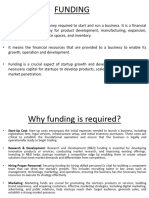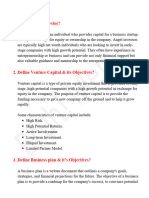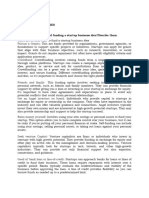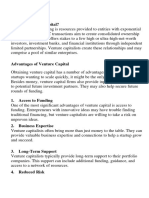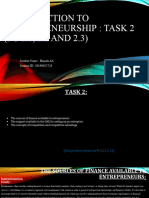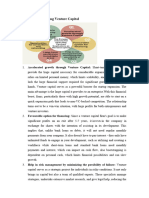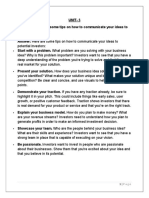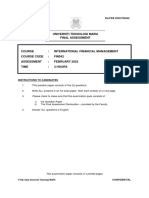0 ratings0% found this document useful (0 votes)
14 viewsEship 1
Eship 1
Uploaded by
rishikarathore145Copyright:
© All Rights Reserved
Available Formats
Download as DOCX, PDF, TXT or read online from Scribd
Eship 1
Eship 1
Uploaded by
rishikarathore1450 ratings0% found this document useful (0 votes)
14 views20 pagesOriginal Title
eship 1
Copyright
© © All Rights Reserved
Available Formats
DOCX, PDF, TXT or read online from Scribd
Share this document
Did you find this document useful?
Is this content inappropriate?
Copyright:
© All Rights Reserved
Available Formats
Download as DOCX, PDF, TXT or read online from Scribd
Download as docx, pdf, or txt
0 ratings0% found this document useful (0 votes)
14 views20 pagesEship 1
Eship 1
Uploaded by
rishikarathore145Copyright:
© All Rights Reserved
Available Formats
Download as DOCX, PDF, TXT or read online from Scribd
Download as docx, pdf, or txt
You are on page 1of 20
1.
Startups can choose from a variety of funding
options, each with pros and cons of their own. The
following are some typical startup funding options:
. Bootstrapping: This method of financing a
business's operations entails using credit cards,
personal savings, or earnings from the venture.
Founders are able to keep complete control over
their company and are spared from having to give
up equity or incur debt thanks to this method.
However, due to limited resources, bootstrapping
may limit the startup's potential for growth and
put a heavy financial burden on the founder.
Benefits: Bootstrapping entails financing the
startup with money from friends and family,
personal savings, or earnings from the business. It
provides total control over the company without
increasing debt or dilution of ownership. It
promotes resourcefulness and frugal living, which
makes an organization leaner and more effective.
Cons: Due to limited resources, bootstrapping may
restrict the startup's potential for growth. The
founder(s) may also experience severe financial
hardship, particularly if the company does not
make money right away.
Wealthy people known as "angel investors" lend
money to start-ups in exchange for convertible
debt or equity ownership. In the early phases of a
startup, angel investment can offer critical funding
as well as insightful connections, industry
knowledge, and mentoring. Angel investors,
however, often have high expectations for their
money and have the power to shape the course of
the company.
Benefits: Wealthy people known as angel investors
donate money in return for convertible debt or
equity ownership. They frequently provide the
startup with invaluable networking opportunities,
mentorship, and industry experience. Early on,
when other sources of funding might not be
available, angel investments can provide vital
funding.
Cons: Giving up some ownership and control over
the company is usually a requirement of angel
investment. In order to appease investors,
founders might feel pressure to hit ambitious
growth goals. It can also be difficult to find the
ideal angel investor who shares the startup's vision
and objectives.
Venture Capital : In return for equity, venture
capital firms invest institutional funds in high-
growth startups. VC funding can supply substantial
capital to support quick expansion, grow
operations, and penetrate new markets. Venture
capitalists frequently provide business scaling
experience, industry connections, and strategic
advice.
Benefits: In exchange for equity, venture capital
firms invest institutional funds in high-growth
startups. Venture capital (VC) funding can supply
substantial capital to support quick expansion,
grow operations, and penetrate new markets.
Venture capitalists frequently provide business
scaling experience, industry connections, and
strategic advice.
Cons: High returns on investment are expected
with venture capital, which could put pressure on
businesses to put expansion ahead of profitability.
When VC firms buy bigger shares in the company,
founders may feel less in control and their
ownership diluted. Moreover, venture capital
funding rounds can be drawn out and competitive.
Crowdfunding: By means of online campaigns,
crowdfunding platforms enable startups to secure
financial support from a multitude of individual
investors or backers. Crowdfunding can provide
early customer feedback, create buzz, and validate
product or market demand. It provides capital
access without requiring debt or giving up equity.
The success of crowdfunding, however, hinges on
efficient marketing and campaign management;
platforms may impose fees or demand that
campaigns reach funding targets in order to
receive funds.
Benefits: Through online campaigns, crowdfunding
platforms enable businesses to raise money from a
large number of individual backers or investors.
Crowdfunding can create buzz, validate product or
market demand, and get early feedback from
customers. It provides capital access without
requiring the surrender of equity or incurring debt.
Cons: Successful crowdfunding campaigns depend
on efficient marketing and campaign
administration, which can take a lot of time and
call for a strong web presence. Certain platforms
impose fees or mandate that campaigns fulfill
fundraising targets in order to obtain funding.
Furthermore, startups may face competition if
their business plans and ideas are made public.
Bank Loans and Credit Lines: Conventional banks
and financial institutions offer loans and credit
lines to startups seeking funding. Access to capital
with fixed interest rates and repayment terms is
provided by bank financing. It can enhance
financial discipline and help build a credit history.
But bank loans are hard for early-stage startups to
get because they usually need collateral and a
good credit history. Payback obligations can put a
pressure on cash flow, particularly if the company
encounters unforeseen difficulties.
Benefits: Conventional bank credit cards and loans
provide access to funds with predetermined terms
of repayment and interest rates. They don't
require giving up control or equity and offer
flexibility in how money is used. Bank financing can
enhance financial discipline and help build a credit
history.
Cons: Bank loans are difficult for early-stage
startups to get because they usually require
collateral and a strong credit history. Startups
without a track record or assets to back the loan
may pay higher interest rates. Repayment
obligations can also put a pressure on cash flow,
particularly if the company encounters unforeseen
difficulties.
Government Grants and Subsidies: These forms of
funding give startups access to non-dilutive capital
for R&D, innovation, and targeted industry
projects. They can help startups in fields like
technology, healthcare, and renewable energy that
are given priority by policy. Nonetheless, there can
be intense competition for grants, and they
frequently have strict eligibility requirements,
application procedures, and reporting obligations.
Benefits: Startups can receive non-dilutive funding
from government grants and subsidies for R&D,
innovation, and targeted industry projects. They
can help startups in fields like technology,
healthcare, and renewable energy that are given
priority by policy.
Drawbacks: Government grants frequently have
strict application procedures, eligibility
requirements, and reporting obligations. Since
funding for grants is limited, competition for them
can be intense. Funding delays for startups can
also be a result of bureaucratic procedures and
approvals.
2. In-depth information about a company's goals,
objectives, tactics, and operational specifics are
contained in a business plan. In addition to offering a
framework for managing and expanding the company
over time, it acts as a road map for the startup phase.
These essential components are usually found in a well-
written business plan:
Original Report: A summary of the business
concept, mission statement, primary goals, and
financial projections are included in this section
that gives an overview of the business plan. It
should attract the reader to keep reading and
clearly convey the business's value proposition.
Explanation of Business: Give a brief description of
the company's characteristics, including its target
market, industry, and USP.
Analysis of the Market: To determine the target
market, rivals, and market trends, conduct market
research. Examine the market's size, potential for
expansion, and the characteristics and inclinations
of the target audience. Evaluate the market's
opportunities, threats, weaknesses, and strengths
using a SWOT analysis.
Sales and Marketing Plan: Describe the methods
used to draw in and keep consumers. Specify the
distribution routes, price policy, marketing
approaches, and branding projects. Explain how
the company plans to stand out from the
competition and increase brand recognition.
Plan of Operations: Describe the business's
operational aspects, such as its location, facilities,
equipment, and staffing needs. Explain the
procedures for assuring quality control, controlling
inventory, and delivering goods or services. Talk
about any legal or compliance requirements that
the company needs to meet.
Organization and Management: List the important
members of the management team along with
their duties. Provide an organizational chart that
shows the company's authority structures and
reporting lines. Emphasize the team members'
credentials, backgrounds, and areas of expertise.
Plan of Finances: Create a thorough financial plan
with forecasts for revenue, profit, and loss, as well
as startup costs. Create a thorough budget that
breaks down costs for things like rent, utilities,
salaries, marketing, and equipment acquisition.
Incorporate break-even analysis and cash flow
projections to evaluate the business's financial
sustainability.
. Appendices: Provide any extra details or
supporting documentation that is pertinent to the
business plan, such as references, market research
reports, market research reports on key personnel,
and legal documents.
Let's start a business now.
High Level Synopsis:
Fitness Gym is a high-end fitness center in [City]
that provides cutting-edge equipment,
individualized training plans, and an inspiring
atmosphere for people of all fitness levels. Our
goal is to provide our members with the best
possible fitness experiences and unmatched
customer service so they can reach their health
and wellness objectives.
About the Business:
Strength training, cardiovascular exercises, group
fitness classes, and personal training sessions are
just a few of the fitness services that Fitness Gym
will offer. People looking to get fitter, reduce
weight, gain muscle, or improve their general
health and wellbeing can all find what they're
looking for in our gym.
Market Evaluation
The importance that consumers place on fitness
and health is fueling the steady growth of the
fitness industry in [City]. Adults are part of our
target market.
Fitness Gym's marketing and sales strategy will
involve a multi-channel approach that includes
social media advertising, local partnerships,
community events, and referral programs in order
to draw in and keep customers. We plan to provide
attractive membership packages, referral
discounts, and exclusive offers to encourage new
members and boost recurring memberships.
Operations Plan: The Fitness Gym will be situated
in a busy area of [City], close to parking lots and
public transportation. Our gym will have state-of-
the-art equipment, roomy training sections, and
extras like smoothie bars, locker rooms, and
showers. To fit our members' schedules, we will
provide flexible operating hours.
Administration and Structure: [Founder Name], a
fitness enthusiast with [X] years of experience in
the fitness sector, founded Fitness Gym.
Financial Plan: Leasehold improvements,
equipment purchases, marketing costs, and initial
operating capital are all included in the estimated
250,000rs startup costs for Fitness Gyms. With a
20% net profit margin, we anticipate 500,000rs in
revenue in the first year. Within the first 12 months
of operation, we anticipate reaching our break-
even point.
annexures:
key team members' resumes
Market research studies on the [City] fitness sector
Equipment quotes and supplier agreements; a
lease agreement for the gym location
Forecasts of cash flow and financial estimates
3. Before investing large sums of money, entrepreneurs
and business owners must conduct feasibility studies to
determine the viability and potential success of a new
venture. Through the identification of potential risks,
opportunities, and challenges related to the suggested
business idea, these studies assist stakeholders in
making well-informed decisions and avoiding potential
pitfalls. This article discusses the value of feasibility
studies as well as some standard instruments and
methods for determining a venture's viability:
The Value of Feasibility Research is :
Risk Mitigation: Early in the planning phase,
feasibility studies assist in identifying possible risks
and obstacles, enabling business owners to create
plans to successfully mitigate or handle them.
Resource Allocation: Entrepreneurs can ascertain
the resources needed to establish and run a
business by evaluating the venture's viability.
Market Understanding: Demand, competition, and
trends are just a few of the variables of the market
that are examined in feasibility studies. This offers
insightful information about market prospects and
assists business owners in customizing their
products to successfully satisfy client needs.
Decision Making: Feasibility studies give interested
parties the knowledge they need to decide
whether to move forward with the proposed
project or not. This lessens the possibility of
devoting time and funds to endeavours with little
chance of success.
Investor Confidence: Doing a feasibility study
shows diligence and professionalism to investors,
which boosts their faith in the business's chances
of success. This is especially important for startups
looking for outside funding.
Feasibility Analysis Instruments and Methods:
Market Research: This entails obtaining and
examining information on target consumers, rivals,
market size, growth potential, and industry trends.
SWOT Analysis: Analysis of the venture's external
opportunities and threats, as well as its internal
strengths and weaknesses, is done using the SWOT
method (Strengths, Weaknesses, Opportunities,
Threats). This analysis aids in determining whether
the business idea is feasible given its internal
resources and the external business environment.
Financial Projections: Projections pertaining to
finances entail estimating income, costs, gains, and
cash flows for the suggested enterprise. The
financial viability and profitability of the business
are evaluated with the aid of methods like break-
even analysis, cash flow forecasts, and income
statement projections.
Technical Feasibility: It entails assessing elements
like the necessity for infrastructure, technology,
and operational procedures in order to guarantee
the viability of delivering products.
Legal and Regulatory Analysis: This section entails
assessing license requirements, permits, and other
pertinent legal issues in relation to the proposed
venture.
Risk Assessment: Risk assessment entails locating
and assessing possible risks and uncertainties
related to the business venture, such as financial,
operational, legal, and market risks. Risks are
ranked and quantified to help guide risk
management strategies. Methods like risk
matrices, scenario analysis, and sensitivity analysis
are some examples of these techniques.
Businesses can evaluate the viability of their ventures
and decide whether to move forward with their
business ideas by conducting thorough feasibility
studies using these tools and techniques.
4. Businesses trying to grow and become more
visible in the market need to implement expansion
strategies. These tactics cover different methods
for growing a company's operations, breaking into
untapped markets, or gaining market share. The
following are a few typical categories of growth
tactics:
In order to grow and become more visible in the
market, businesses must implement expansion
strategies. In order to grow operations, penetrate
new markets, or gain market share, these
strategies use a variety of techniques. Typical
categories of growth tactics include the following:
Increasing market share within already-existing
markets or customer segments is known as
market penetration:Adopting aggressive pricing
tactics, running marketing initiatives, improving
products, or expanding distribution networks can
all help achieve this.
Benefits: Utilizes pre-existing infrastructure and
resources, expanding upon previous customer
base and brand recognition.
Cons: In saturated markets, there is less room for
expansion, which could result in price wars and
lower profits.
Market Development: Market development is the
process of introducing current goods and services
into new markets or clientele. Potentially, Market
Development: Targeting new markets or clientele
with current offerings is the main goal of market
development. This could entail expanding
geographically into new areas, focusing on new
demographic segments, or meeting various client
demands.
Benefits: Increases revenue streams and
customer base while lowering reliance on current
markets.
Cons: May entail greater expenses and risks;
demands market research and adaptation to
changing market conditions.
Product Development: Introducing new goods or
services to current markets is the responsibility of
product development. In order to adapt to shifting
customer needs or preferences, this may entail
innovations, updates, or extensions of current
offerings.
Benefits include increased competitiveness,
customer acquisition, and product portfolio
diversification.
Cons: Needs to spend money on product testing,
marketing campaigns, and research and
development.
Diversification: - Diversification is growing into new
markets or sectors of the economy that have
nothing to do with the products or services the
company currently offers.
Benefits: Disperses risk over several companies or
sectors, opens up new revenue sources, and
promotes expansion.
cons: higher risk because of unfamiliarity with new
markets or industries; requires substantial
investment, experience, and resources.
Horizontal Integration - This type of integration
entails buying out or joining forces with rival
businesses that are involved in the same sector of
the market or industry. As a result, businesses can
achieve economies of scale, increase their market
share, and consolidate their operations.
Benefits: Reduces rivalry, increases market
presence, and strengthens negotiating position
with vendors and clients.
Cons: Difficulties with integration, regulatory
scrutiny, and antitrust issues.
5. In their business endeavours, entrepreneurs
encounter a range of risks and obstacles that may have
an effect on the longevity and prosperity of their
companies. These risks can originate from both internal
and external sources, and they can change based on
the kind of business, the market, and the industry. The
following are some typical risk scenarios that business
owners could run into:
Market Risk: - Market risk is the unpredictability of
alterations in market circumstances, such as
modifications in consumer inclinations, variations
in demand, or adjustments in the dynamics of
competition. It can be difficult for business owners
to foresee market trends with enough accuracy
and to modify their goods and services to suit
shifting consumer demands.
Financial Risk: - A number of variables, including
low capitalization, cash flow issues, high debt
levels, and reliance on outside funding sources,
can lead to financial risk.
Operational Risk: - Operational risk is caused by
internal elements that affect how a business
operates, like production problems, supply chain
disruptions, issues with quality control, or
technological malfunctions. Process optimization,
logistics management, and maintaining operational
efficiency while reducing interruptions and
downtime can be difficult tasks for entrepreneurs.
Legal and Regulatory Risk: Non-compliance with
laws, regulations, or industry standards governing
business operations results in legal and regulatory
risk. It can be difficult for entrepreneurs to
navigate complicated regulatory environments, get
licenses and permits, deal with legal issues,
lawsuits, or fines from the government.
Reputational Risk: Reputational risk results from
unfavourable opinions or press that may harm the
company's credibility, brand image, or level of
reliability. Entrepreneurs may encounter difficulties
in handling customer complaints, handling public
relations.
Technological Risk: This type of risk arises from the
quick development or modification of technology,
which has the potential to upend established
business models, procedures, or goods. In an
increasingly digital and linked world, entrepreneurs
may encounter difficulties implementing new
technologies, maintaining their competitiveness,
or safeguarding their intellectual property rights.
Human Resource Risk: Problems with workforce
management, employee churn, talent shortages,
and skill gaps are examples of human resource risk
factors. It can be difficult for entrepreneurs to find
and keep qualified workers, to create a happy work
environment, or to resolve conflicts and problems
with behaviour or performance.
Environmental and Sustainability Risk: This type of
risk relates to how possible it is that environmental
issues, climate change, or sustainability concerns
will affect how businesses operate and conduct
business.
Entrepreneurs must implement proactive risk
management techniques in order to effectively
manage these risks. These techniques include careful
planning, backup plans, diversification, insurance
coverage, compliance checks, and ongoing
monitoring and assessment of risk factors.
Entrepreneurs can improve their business ventures
resilience, sustainability, and success by recognizing
and mitigating potential risks early on.
You might also like
- Netscape Case SolutionDocument6 pagesNetscape Case SolutionMaksym Malovichko60% (5)
- Biriyani by KiloDocument6 pagesBiriyani by KiloPoornima SisodiyaNo ratings yet
- Campus PizzeriaDocument5 pagesCampus PizzeriaJotika MaheshwariNo ratings yet
- Eship 1Document21 pagesEship 1rishikarathore145No ratings yet
- Business Plan and PlanningDocument4 pagesBusiness Plan and PlanningHugoh Kansirgi DavidNo ratings yet
- 2022 SolDocument17 pages2022 SolKhokher ChetanNo ratings yet
- FUNDINGDocument9 pagesFUNDINGRishika SinghNo ratings yet
- Strategic Financial ManagementDocument11 pagesStrategic Financial ManagementmiscemailkkayNo ratings yet
- Mayank Aggarwal - June ReportDocument4 pagesMayank Aggarwal - June ReportMayank AggarwalNo ratings yet
- Financing and Fundraising for the Circular Economy BusinessesDocument19 pagesFinancing and Fundraising for the Circular Economy BusinessesjanaviloveNo ratings yet
- Most BusinessDocument6 pagesMost Businesssridhar KMNo ratings yet
- Venture Capital PDFDocument8 pagesVenture Capital PDFshifahamiddNo ratings yet
- 10 Funding OptionsDocument6 pages10 Funding OptionsjbryanNo ratings yet
- Sources of Funds For EntrepreneursDocument5 pagesSources of Funds For Entrepreneursjames vishdasamNo ratings yet
- Fund Raising 4 Start-UpsDocument8 pagesFund Raising 4 Start-UpsMister PhilipsNo ratings yet
- L9Document12 pagesL9ragidir265No ratings yet
- Startup Funding Rounds: 60% of All Startups NeedDocument9 pagesStartup Funding Rounds: 60% of All Startups Needs gurung100% (1)
- Boe AnswersDocument6 pagesBoe Answerskandikatlavarsha2002No ratings yet
- Venture Capial and Angel FinancingDocument8 pagesVenture Capial and Angel Financingshaunakgaddime1No ratings yet
- Capital Catalyst: The Essential Guide to Raising Funds for Your BusinessFrom EverandCapital Catalyst: The Essential Guide to Raising Funds for Your BusinessNo ratings yet
- What Is Venture Capital?Document9 pagesWhat Is Venture Capital?Stephane Labrosse100% (1)
- Entrepreneurship AssignmentDocument7 pagesEntrepreneurship AssignmentMazhar ArfinNo ratings yet
- Inbound 3694420833975007859Document4 pagesInbound 3694420833975007859Roselle Luzano GalugaNo ratings yet
- Incorporation:: Incorporation, Investment, and Intellectual Property For Start-Ups in IndiaDocument5 pagesIncorporation:: Incorporation, Investment, and Intellectual Property For Start-Ups in IndiaRISHAB RNo ratings yet
- Module 3 Financial Incentives and Funding ProgramsDocument13 pagesModule 3 Financial Incentives and Funding ProgramsAxel HagosojosNo ratings yet
- Start Your Start Up (Answer)Document5 pagesStart Your Start Up (Answer)Kushal AgarwalNo ratings yet
- Inbound 7018310794352435496Document8 pagesInbound 7018310794352435496Roselle Luzano GalugaNo ratings yet
- Entrepreneurship FundsDocument3 pagesEntrepreneurship Fundssahil2200singhNo ratings yet
- Capital VenturesDocument4 pagesCapital Ventures114325jishnuNo ratings yet
- Cif (Ese)Document43 pagesCif (Ese)ravichandra nagarNo ratings yet
- Marquee JulyDocument3 pagesMarquee JulyMayank AggarwalNo ratings yet
- Venture CapitalDocument17 pagesVenture CapitalNor Azlan RamliNo ratings yet
- Mayank Aggarwal August2022Document4 pagesMayank Aggarwal August2022Mayank AggarwalNo ratings yet
- Topic 2.1 - Raising Finance Learning Outcome The Aim of This Section Is For Students To Understand The FollowingDocument8 pagesTopic 2.1 - Raising Finance Learning Outcome The Aim of This Section Is For Students To Understand The FollowinggeorgianaNo ratings yet
- Unit 2 Venture FinanceDocument8 pagesUnit 2 Venture Financelaket64875No ratings yet
- List The Elements of A New-Venture Team?Document11 pagesList The Elements of A New-Venture Team?Amethyst OnlineNo ratings yet
- Business Plan & Access To Funding: Presented byDocument19 pagesBusiness Plan & Access To Funding: Presented bykarthikNo ratings yet
- Access To FinanceDocument2 pagesAccess To FinanceClifford TafaraNo ratings yet
- Sme Finance: Best-Practice GuidelineDocument16 pagesSme Finance: Best-Practice GuidelinesgdfgfdfNo ratings yet
- Business Plans NotesDocument4 pagesBusiness Plans NotesT.ThomasNo ratings yet
- Funding - StartupsDocument6 pagesFunding - Startupsshobitanadeola2005No ratings yet
- How To Write Business Plan ChapterDocument24 pagesHow To Write Business Plan ChapterZANo ratings yet
- BAA611 Introduction To Entrepreneurship: Task 2 (PC 2.1, 2.2 AND 2.3)Document17 pagesBAA611 Introduction To Entrepreneurship: Task 2 (PC 2.1, 2.2 AND 2.3)wowzyfashooNo ratings yet
- Stages of Company Development and Investor TypesDocument5 pagesStages of Company Development and Investor TypesLuis DiazNo ratings yet
- GROUP ASSIGNMENT xxxDocument12 pagesGROUP ASSIGNMENT xxxINNOCENT MUTUMBWE (JONAS KOBAMA)No ratings yet
- Sources of CapitalDocument6 pagesSources of CapitalSumon Bera0% (1)
- Startup Unit 4Document17 pagesStartup Unit 4Sanjan rajNo ratings yet
- Enterpreneureship and BusinessDocument17 pagesEnterpreneureship and BusinessSumbal AminNo ratings yet
- VC Funding Business PlanDocument8 pagesVC Funding Business Plannhpsbyoyf100% (1)
- Venture Capital Funding - FSDocument14 pagesVenture Capital Funding - FSashaya_j_007No ratings yet
- A Report On Analysis of Venture Capital As A Source of FinanceDocument21 pagesA Report On Analysis of Venture Capital As A Source of Financearun883765No ratings yet
- Lecture Notes 8 On Sources of FinanceDocument31 pagesLecture Notes 8 On Sources of FinanceJohn Bates Blankson100% (7)
- Cash Flow and Credit and Background InvestigationDocument5 pagesCash Flow and Credit and Background Investigationjan francis marianoNo ratings yet
- Chapter 12Document14 pagesChapter 122020208100No ratings yet
- How Venture Capital Firms WorkDocument8 pagesHow Venture Capital Firms Worksanket sunthankarNo ratings yet
- Entrepreneurship Handbook by Harshit MishraDocument10 pagesEntrepreneurship Handbook by Harshit MishraInfowalaharshNo ratings yet
- Reasons For Selecting Venture CapitalDocument2 pagesReasons For Selecting Venture Capitalkan078bct017No ratings yet
- Equity Crowdfunding GuideDocument9 pagesEquity Crowdfunding GuideAgroEmpresario ExportadorNo ratings yet
- Entrepreneurship UNIT - 5 & 6Document15 pagesEntrepreneurship UNIT - 5 & 6Sayantan MajhiNo ratings yet
- Bus FinanceDocument11 pagesBus FinanceLeo RajNo ratings yet
- Financail Market Institution and Financial ServiceDocument6 pagesFinancail Market Institution and Financial Servicesuraj agarwalNo ratings yet
- EntrepreneurshipDocument10 pagesEntrepreneurshipclashofclans00811No ratings yet
- Quiz 2 Version 1 SolutionDocument6 pagesQuiz 2 Version 1 SolutionEych MendozaNo ratings yet
- Banking Professional-Members-Directory-as-on-31-10-2019 PDFDocument147 pagesBanking Professional-Members-Directory-as-on-31-10-2019 PDFSK Business groupNo ratings yet
- Final GeojeetDocument78 pagesFinal Geojeetanon_273814783100% (1)
- Regular Income TaxationDocument6 pagesRegular Income TaxationAnabel Lajara Angeles0% (1)
- 1 2Document2 pages1 2Benedict TiengoNo ratings yet
- CFE - SNL Bank Valuation BrochureDocument5 pagesCFE - SNL Bank Valuation BrochureFahad MirNo ratings yet
- ProcessForce License Comparison Chart 2021Q4Document7 pagesProcessForce License Comparison Chart 2021Q4tomar@vp.plNo ratings yet
- NPO StandardsDocument9 pagesNPO Standardsbngo01No ratings yet
- 223 Bob Statement PDFDocument4 pages223 Bob Statement PDFdhirendraNo ratings yet
- MBB Shopee Card - FaqDocument4 pagesMBB Shopee Card - FaqAfif FakhreeNo ratings yet
- A Financial and Operational Analysis of Banco de Oro: 1.1 Background of The StudyDocument6 pagesA Financial and Operational Analysis of Banco de Oro: 1.1 Background of The StudyCheryl GanitNo ratings yet
- Project On Merchant BankingDocument56 pagesProject On Merchant BankingBronil W DabreoNo ratings yet
- Deutsche Bank and The Road To Basel - IIIDocument20 pagesDeutsche Bank and The Road To Basel - IIISHASHANK CHOUDHARY 22No ratings yet
- Indian Financial MarketsDocument11 pagesIndian Financial Marketsvcpc2008No ratings yet
- 2019 Pre Bar Lecture in Banking and SPCL (070919) - Mjrsi PDFDocument22 pages2019 Pre Bar Lecture in Banking and SPCL (070919) - Mjrsi PDFLeslie Javier BurgosNo ratings yet
- Faculty Business Management 2022 Session 1 - Degree Fin542Document4 pagesFaculty Business Management 2022 Session 1 - Degree Fin542ilmanNo ratings yet
- Governance 29 May 06 PDFDocument10 pagesGovernance 29 May 06 PDFrehanNo ratings yet
- MTP May21 ADocument11 pagesMTP May21 Aomkar sawantNo ratings yet
- Public Auction NoticeDocument3 pagesPublic Auction NoticehashimhasnainhadiNo ratings yet
- Practice Exam 02 S04 312S05Document13 pagesPractice Exam 02 S04 312S05azirNo ratings yet
- Saving MoneyDocument1 pageSaving MoneyAnis Mohammed Nasser QasimNo ratings yet
- Intership ReportttttttDocument29 pagesIntership Reportttttttsehrish MalikNo ratings yet
- Chapter-: Vi: Suggestions & ConclusionDocument7 pagesChapter-: Vi: Suggestions & ConclusionNishobithaNo ratings yet
- Financial StatementDocument4 pagesFinancial StatementJoshNo ratings yet
- Audithow Com Auditing of Operating ExpensesDocument8 pagesAudithow Com Auditing of Operating ExpensesMunyaradzi Onismas ChinyukwiNo ratings yet
- Interest Rates: Type Interest Rate Savings AccountDocument16 pagesInterest Rates: Type Interest Rate Savings Accountrohanfyaz00No ratings yet
- 7110 s03 Er PDFDocument4 pages7110 s03 Er PDFShadman ChowdhuryNo ratings yet
- MA516-833 Contingencies I Section 12 Contingent Assurances and Reversionary Annuities HandoutDocument8 pagesMA516-833 Contingencies I Section 12 Contingent Assurances and Reversionary Annuities HandoutYomi BrainNo ratings yet






